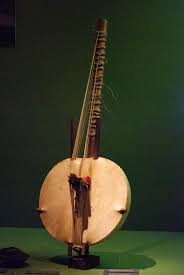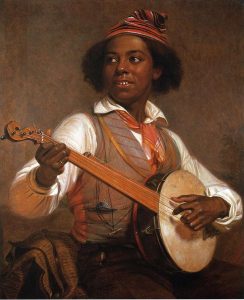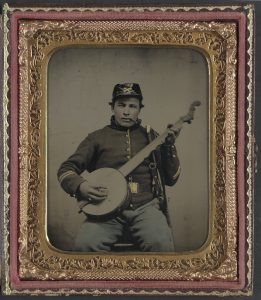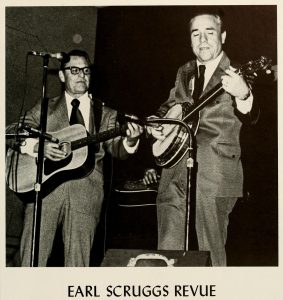America’s musical history has long been influenced by one instrument. Whether jazz, folk, country, bluegrass or even some Rock-and-Roll albums, the banjo has been ingrained into American culture. In this article, I examine where the banjo came from and how it still influences our culture today.
Akonting: Original Banjo
The banjo was born probably around 6000 years ago in ancient Africa. It originally had only 4 strings (one being the drone string) and was made by slinging a piece of hide over a hollowed-out gourd. A large piece of wood would then be pieced through the gourd and held tight with wooden pegs or twine. The whole instrument would then be adorned with gut strings that would be attached to wooden tuning pegs at the peghead (the top of the banjo) and at a tailpiece at the end of the head. It would be held up at the top on the ‘nut’ (usually a piece of bone) and on a floating bridge (usually a piece of maple) that rests on the head. The fact that the bridge is ‘floating’ which is to say it isn’t attached to the head, rather it can be moved to adjust intonation, is interesting. Its nature is similar to that of a violin and most other classical instruments. This early description of the banjo comes from accounts of many native Africans and European explorers. The instrument itself has seldom changed in Africa and one of the most closely related ancestors of such an instrument is the Akonting. It is made and played in an almost identical manner to the original, traditional instrument.

The instrument was carried to America in the 1600s via the slave trade. Many African slaves either brought it with them or built their own once in America. In parts of the Caribbean, the banjar, as it is locally known, stills thrives.
Early America: Building the Banjo
The banjo was mostly played by slaves and was disseminated throughout America. Early accounts place the banjo just outside the city of New York in the early 1750s. Judging by the nature of these accounts it is clear that the banjo was well known among most people. This is to say the banjo was not a “foreign” instrument. An example of these early accounts is a flyer that advertises a reward for the capture of an escaped slave. It describes the slave as being “a banjo player” or it says “he might be carrying a banjo.” These descriptions make it clear that even in early American history, the banjo was common.
As history progressed, the banjo became more known and played. Even lower-class white folk in the south began to pick up and play the banjo.
The banjo at this time was played in an old-time style known today as clawhammer, frailing, rapping, or just simply as old-time picking. This style was and still is very similar to how the banjo would have been played in West Africa at the time of its dawning. The style is characterized by the down-picking of the individual strings with the nail of either your index or middle finger followed by a brush of all the strings, barring the 5th drone string, with either both your index and middle or all of your fingers then followed the pull off of the 5th string with your thumb. This style was how the banjo was played for most of its existence and has been made a major part of culture today with the folk revival in the 60s.

This clawhammer banjo style and its variations persisted through the early 1900s with famous players like Pete Seeger, George Gibson, and Doc Boggs.
Joel Walker Sweeney
Around the 1800s, the banjo began to be adapted more into pop culture with the emergence of the blackface minstrels. This form of entertainment made the banjo well known among people all over the US. One of the early performers was Joel Walker Sweeney. A banjo player himself born in 1810 in Buckingham County, Virginia, Sweeney found a new way to build the banjo. Sweeney used a machine-made wooden pot with a metal tension hoop and screws to hold down the hide head. He made the tailpieces out of metal, rather than wood, and, most importantly, added the bass string to the banjo. This 5 string banjo is now the most popular variation of the instrument. Sweeney’s contributions to the construction of the modern-day banjo were immense.

This banjo played clawhammer style would be the most popular throughout America for a century only being modified a bit. Companies like Fairbanks and Cole, Vega, S.S. Stewart, and many more are recognized as the most influential companies in the creation of old-time banjos between 1800 and 1930.

Earl Scruggs and Bluegrass
In 1945, the world of music, was shattered by the debut of Bill Monroe’s band “Bill Monroe and The Bluegrass Boys” featuring Earl Scruggs playing his innovative banjo style on WSM-radio’s Grand Old Opry. Earl’s style of playing was incredibly influential and new. He drew from some other lesser-known banjo players’ ideas, such as the likes of Snuffy Jenkins. None of these early players, however, would display the drive, power, and influence of Earl’s playing. The three-finger bluegrass picking style is characterized by the up-picking motion of the revolving index, middle, and thumb fingers wearing picks. This series of quickly alternating arpeggios birthed the possibility of new, more elegant ways of playing old traditional American folk music.


Earl’s style of playing revolutionized America’s musical persona with many attributing the creation of Bluegrass to the day Earl Scruggs joined Bill Monroe’s band. He would later play with Lester Flatt, forming the band “The Foggy Mountain Boys.” Their music has inspired many new banjo pickers for years. Earl’s “Foggy Mountain Breakdown” is his best-known piece, popularized by its debut in the movie “Bonnie and Clyde.” Flatt and Scruggs also wrote and played the theme song to “The Beverly Hillbillies,” a song they titled “The Ballad of Jed Clampett,” further ingraining the banjo into pop culture. In the late 60’s, however, following Earl’s desire to play new, rock music and Lester’s dislike for Earl’s liberal politics, the band would break up.
From Folk To Pop Culture: The Banjo in the Modern Age
In the early 60’s, the folk revival could be seen as a rebirth of the banjo, its image being brought to the world stage. In the 70’s, players such as Bill Monroe, Bobby Thompson, and later Tony Trischka revolutionized the banjo’s playing with melodic style, a playing style in which you try to play note-for-note what the fiddler is playing. Players such as Don Reno in the 50’s and Béla Fleck today introduced more new ways to play the banjo with the guitar-like single-string style. Others like Jim Mills have attempted to keep the bluegrass style alive with fast, bold, loud banjo picking that revivifies Earl’s tradition.


Otherwise, players like Béla and Noam are redefining what can be done with the banjo. They are working to blur the lines between these new styles and the traditional banjo cultures.
